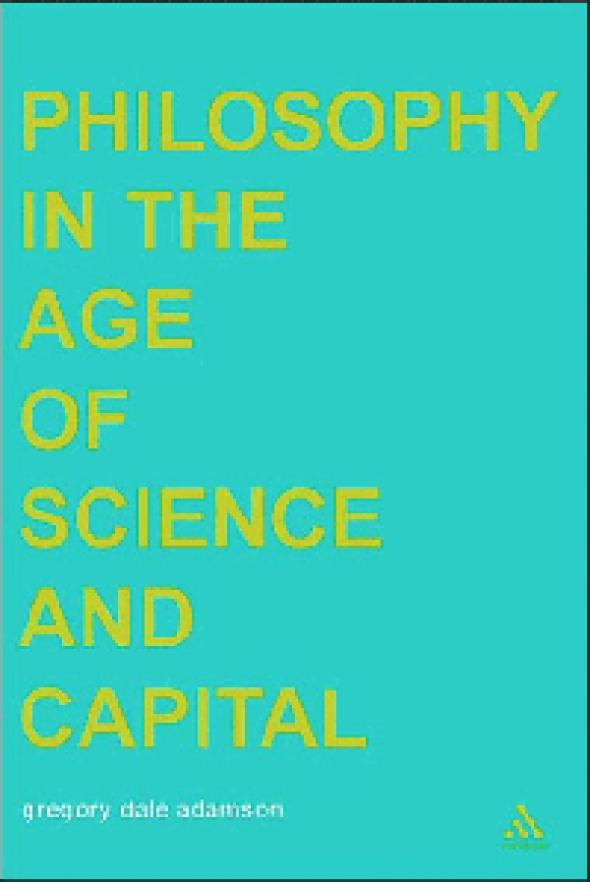Philosophy in the Age of Science and Capital
by De Selby--
An important and infuriating book, in which insights of the utmost urgency are smeared by association with disastrously insipid conclusions. The intersection of Henri Bergson’s thought with recent evolutionary theory generates a strong account of lived, ‘affective’ experience’s continuity (‘duration’) as something thinkable yet inaccessible to the spatial (or, in Bergson’s terms, ‘intellectual’) representation grounding scientific method. Objective representation requires the abstraction of a ‘snapshot’, an ‘instance’ presumed to be internally unchanging, from the indivisible continuity of process. This imposition of timeless form on temporality ‘renders all objective categories inherently Platonic’: the instant is ‘an ideal which measurement and recording approach but can never reach.’ The scientific subject can never successfully isolate the static object from continuous change, because s/he is immanent to that continuity.
Contemporary chaos and complexity theories, in which some commentators see science ‘catching up’ with Bergsonism, actually reinforce spatial representation’s claim to exclusive authority, by consigning everything outside the scope of ‘mechanistic’ abstraction to a mystified realm of pure chance. ‘In practically every introduction to chaos theory’, notes Adamson, ‘the stock market is described as an example of self-determining, and therefore natural, order.’ Daniel Dennett, the leading neo-Darwinist apologist for purely random genetic mutation, espouses a fundamentalist liberal ‘ethics’ of ‘free’ personal choice unaffected by the processes in which the subject lives. Bergson, by contrast, insists on the productive reality of temporal ‘tendencies’ which can be expressed qualitatively but not represented spatially.
Crucially, Adamson addresses these questions in terms of their immediate political stakes. Not only does scientific authority contribute ideologically to the acceptance of existing social conditions as natural, ‘science and capital [...] are both predicated on quantitative difference, making the scientific image of the real the ideal correlate of capitalist production.’ Scientific objectification of temporality, in other words, is bound inseparably to the essence of capital: the abstraction, measure and commodification of labour-time.
Unfortunately, Adamson’s attempt to apply these discoveries to contemporary social phenomena seems to press his entire conceptual construction into the service of the things it is intended to attack. ‘If we are to change the nature of existence’, he declares, ‘it will not be through some proletariat [sic] revolution, but only through the revaluation of thought and values.’ The last two chapters of the book append to the preceding critique of scientific abstraction a loosely Marxist account of the imposition of work through abstraction of labour time. Yet despite the earlier definition of Platonic abstraction as ‘theological’, resistance to work-imposition is quietly relinquished, with contestation displaced to the ideal plane of ‘thought and values’, culture and aesthetics.
Amongst other eccentricities, this section infers from the present scarcity of antagonistic social subjects the end of alienation. More seriously, it insists on ‘science’s’ independence from ‘capitalism’, mistaking capitalism for a finite thing which one can remain external to, rather than an immanent social relation actualised in scientific and other activity. These could conceivably be construed as mere semantic lapses; if so, however, they advertise a sustained inattention to the specificity of the linguistic. Adamson repeatedly reduces language to naming in particular and ‘intellectual’ representation in general. In limiting linguistic process to the denotative function of nouns, he occludes the potential of verbs to express qualitative ‘tendency’, despite his own acknowledgement that duration belongs to a ‘pure infinitive’.
The ultimate source of the book’s idealist conclusion may lie in its failure to question Bergson’s belief that spatialising representation results from the transhistorical, quasi-biological form of ‘intellect’. If the abstract structure of thought that is capitalism’s inseparable ‘correlate’ is natural rather than historically specific, there is likely to be something natural, and therefore inevitable, about the labour-time measure itself. From here there seems little alternative to resigned acceptance of political action’s enervation, its confinement within the symbolic field.
Regardless of the postmodern nihilism its argument unwittingly falls into, though, Adamson’s book contributes decisively to a future deterritorialisation of Bergson’s metaphysical project into a more robust materialist politics. The argument binding together intellectual and capitalist abstractions of temporality is convincing. Read ‘in reverse’, against Bergson’s naturalisation of intellect but in keeping with his intuition that the ‘soma’ of history may determine the ‘germ’ of ‘nature’, it identifies spatialising representation as the mode of thought emerging necessarily in social relations characterised by capitalist work. In turn, this says something about how thought might aspire to exist ‘in and against’ immanent capital. Within any given intellectual practice, it suggests, the element that reproduces existing social relations should be sought and contested in that practice’s image of time.
Mute Books Orders
For Mute Books distribution contact Anagram Books
contact@anagrambooks.com
For online purchases visit anagrambooks.com








